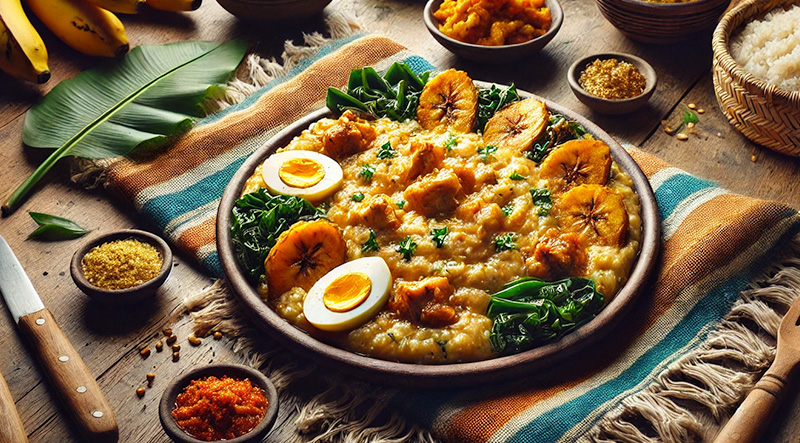Boko Boko Harees, the soulful national dish of Burundi, is a creamy, comforting blend of East African heart and Arab heritage. This slow-cooked porridge made from cracked wheat and tender chicken is gently simmered with fragrant spices and finished with melted butter, creating a rich, velvety texture that warms from the inside out. Often served with fresh herbs, ground spice blends, and a crisp salad on the side, Boko Boko Harees is more than just a meal—it’s a celebration of Burundi’s diverse cultural roots, bringing families together with every spoonful of its savory goodness. Read More...
Origins and Cultural Crossroads: The roots of Boko Boko Harees can be traced back to the ancient Arabian dish Harees (or Harissa), a slow-cooked blend of wheat and meat that has been prepared for centuries across the Middle East. The dish made its way to the East African coast through Indian Ocean trade routes and Islamic cultural exchanges, particularly via Omani and Yemeni traders who settled and influenced parts of the Swahili coast—including Zanzibar, Tanzania, and into Burundi.
In Burundi, this dish took on a local identity. The people adapted Harees to local tastes and ingredients, transforming it into Boko Boko Harees—a version that uses cracked wheat (or sometimes rice), tender chicken, local spices, and melted butter. The name “Boko Boko” is believed to reflect the soft, broken-down texture of the dish, while “Harees” connects it to its culinary ancestry.
A Dish of Faith, Family, and Festivity: Boko Boko Harees is especially significant during religious holidays, such as Ramadan or Eid, where it is served at large gatherings to break the fast. It is also common during weddings, family reunions, and community events, where sharing food from a central platter symbolizes unity and generosity.
The dish requires time and patience—wheat is soaked and slowly simmered with chicken and spices for hours until the grains dissolve into a creamy porridge. The process is unhurried, often involving multiple family members, making it as much about the preparation as the eating. It’s typically served with accompaniments like melted butter, a fresh tomato and herb salad, and a sprinkle of regional spices like cardamom or cinnamon.
Modern-Day Relevance: Today, Boko Boko Harees remains a cherished part of Burundi’s culinary landscape. While its preparation has evolved—some households now use pressure cookers or blend ingredients for faster results—the soul of the dish remains unchanged. In urban centers, it’s a prized traditional meal, while in rural areas, it retains its role as a food of comfort, celebration, and faith.
In a nation where oral tradition is central, the recipe for Boko Boko Harees is often passed down from generation to generation—grandmothers to mothers, fathers to sons—preserving not just technique, but the story of a people who embraced culinary fusion and made it their own.
Boko Boko Harees, with its rich history and creamy simplicity, tells a delicious tale of migration, adaptation, and the enduring power of shared meals. In every spoonful, there’s a reminder of how food connects us—not only to our culture but to one another.
Prep the Wheat:
Cook the Chicken:
Add the Wheat:
Slow Cook to Perfection:

Serve Warm:
Tips:
The preparation and cooking time for Boko Boko Harees is approximately 1 hour and 45 minutes in total. This includes about 15 minutes of prep time for soaking the cracked wheat and prepping the chicken, followed by 30–40 minutes of simmering the chicken to create a flavorful broth, and then another 45–60 minutes of slow cooking the wheat and shredded meat until it transforms into a creamy, porridge-like consistency. The dish requires patience, but the result is a deeply comforting, richly spiced meal worth every minute.
A single serving of Boko Boko Harees, based on the recipe provided (approximately 1.5 cups or 350g), contains an estimated 450 to 600 calories, depending on the amount of butter used and the fat content of the chicken. The cracked wheat contributes around 150–200 calories, while the chicken (especially with skin or dark meat) adds 200–250 calories. Butter and added spices contribute an additional 100–150 calories. Using lean chicken breast, less butter, or omitting cream or yogurt can slightly reduce the calorie count, while still maintaining the dish’s comforting richness.







